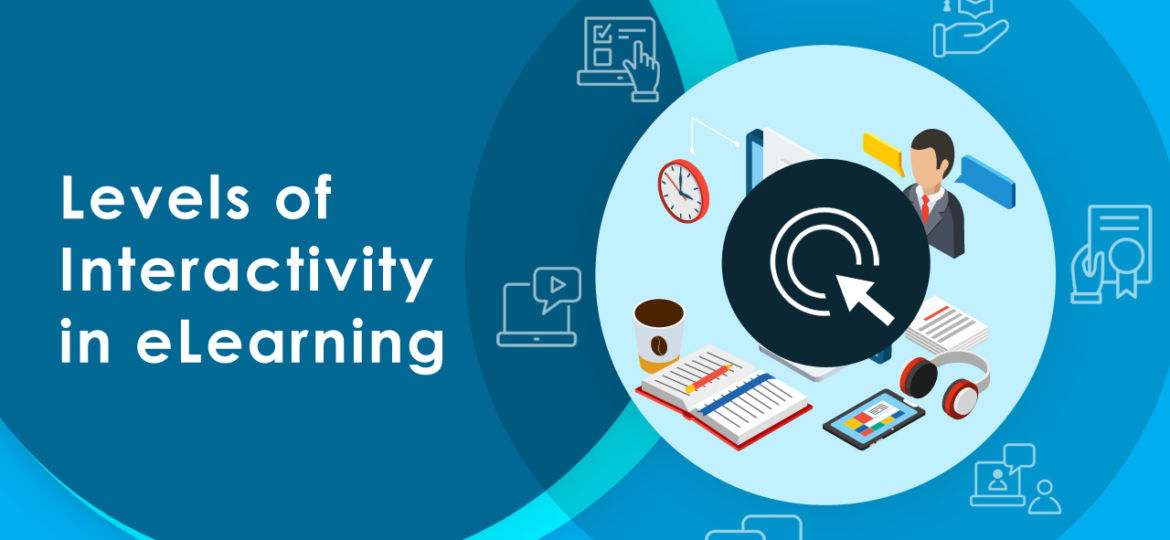
Discover The Levels Of Interactivity Present In eLearning Modules
With the deployment of eLearning growing day by day, more and more research is going into developing interactivities that enhance the learning value of the eLearning module.
What Is Interactivity?
In simple terms, interactivity is any interaction between the learner and the module where the learner gives input, and the module proceeds based on the input given by the learner.
Thus, a simple click, drag-and-drop, or text input can be interactivity. And simulations, games, Augmented Reality, and Virtual Reality are on the higher end of the interactivity spectrum.
What Are The Levels Of Interactivity?
To understand levels of interactivity, we have to first understand two fundamental types of interactivities—behavioral interactivity and cognitive interactivity.
- Behavioral interactivity
It is the physical action performed by the user to complete a task; for example, clicking a button, dragging an item, etc. - Cognitive interactivity
It is the psychological interaction of the course content with the learner; for example, the module may ask a question to the learner which the learner has to answer by thinking.
Levels Of Behavioral Interactivity
Traditionally, behavioral interactivities are classified as levels 1, 2, and 3; or, simple, medium, and complex; or, basic, intermediate, and advanced. All terminologies signify the same.
- Basic/Simple/Level 1
This typically includes only click interactivities, which simply load the content or navigate through slides. - Intermediate/Medium/Level 2
This level typically includes clicks, simple drag-and-drop, and simple text input. - Complex/Advanced/Level 3
This level typically involves clicks, drag-and-drop, text input, simulations, and gaming controls.
Levels Of Cognitive Interactivity
Cognitive interactivities are defined mostly in terms of Bloom’s taxonomy. There are three levels of cognitive interactivity:
- Level 1
This level includes the first two levels of Bloom’s taxonomy, viz., knowledge and comprehension. This includes basic information processing. - Level 2
This level includes the application and analysis levels of Bloom’s taxonomy. This includes information application and analytical abilities. - Level 3
This level includes synthesis and evaluation. This includes problem-solving and decision-making skills.
Levels Of Interactivity In eLearning Modules
In the eLearning industry, levels of interactivity are mainly defined for billing and quantization purposes. Thus, a module with a higher level of interactivity will be charged more than a similar module with a lower level of interactivity.
Due to this reason, the behavioral interactivity, which is mostly related to the use of media and technology, dominates the definition of levels.
There are no specifically defined boundaries between different levels of interactivity. Different organizations follow different ways of classification. The table below summarizes how levels are defined.

Let’s dive a little deeper:
- Level 1 modules
Level 1 eLearning modules comprise mostly static slides containing text and image and a little bit of graphic designing. There can be minor fade-in/fade-out animations. Sometimes, basic click-to-reveal interactivities, tab interactivities, etc. are also included. The content covered is mostly information-based, such as policy updates, rules and regulations, etc. Here, the learner is merely a receiver of the information and usually has very limited or no control over the learning, apart from navigation. - Level 2 modules
Level 2 includes everything from level 1 and advanced click-to-reveal and basic drag-and-drop activities. It also includes basic text and image animations. It can also include simple text inputs. Here, the learner has more control than level 1 over the learning and becomes more engaged with the course content. - Level 3 modules
Level 3 modules encompass a wide range of interactivities and content. It includes click-to-reveal, drag-and-drop, text input, hot spot, etc. The content can be from level 2 or 3. It also includes character illustrations and animations. Video is also included in this level. Here, the learner is most actively involved in learning and also gets to practice what is learned. - Level 4 modules
Level 4 modules include advanced simulations, gaming, branching scenarios, AR/VR based modules. These are the most advanced level interactivities and content.
The table below gives the gist of the levels:

Conclusion
Levels in eLearning modules are defined most primarily from a development point of view. Although there are no fixed standards, the eLearning industry widely accepts four levels of modules.
With the advancement of technology, the definition of models keeps changing. For example, click-to-reveal interactivities used to be considered as level 2 elements only; however, using rapid authoring tools, these can be created so easily that most companies now consider basic interactivities in level 1 only.
Similarly, using simulation capturing tools makes it really easy to publish simulations. So, some companies have started considering software simulation in level 2. So, it ultimately boils down to the client and development company to agree on level definitions.
